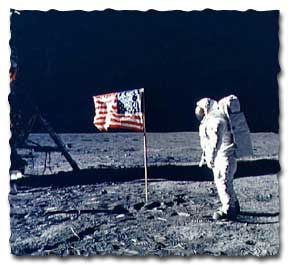Russia Continues to Surpass Americans in the Space Race
 Cosmonauts May Soon Add Another One to the Russian Space List of Firsts
Cosmonauts May Soon Add Another One to the Russian Space List of Firsts
On July 25, 1969, many Americans watched their televisions in awe as astronaut Neil Armstrong walked on the moon and said, "One small step for man, one giant leap for mankind." Americans were amazed at what advances in technology had produced: a man on the moon. Ticker tape parades greeted returning astronauts. America had proven itself a leader in the space race.
Lately, some have begun to suggest that this was not the case at all; some people have suggested that America never made it to the moon and that it was
just an illusion made with trick photography. Bart Sibrel is one of those people. He made a video called, "A Funny Thing Happened on the Way to the Moon," in which he provides much documentation to suggest that man has yet to walk on the moon. Is this possible? Could have America faked the entire moon landing?
On first thought, it might sound ludicrous for many--to think that man has not walked on the moon. After all, it would require such a grand conspiracy that, certainly, someone who was privy to such information would have spoken. Nevertheless, there are those who are skeptical of this moon-walking.
Surprisingly, some of the ideas presented by them are not as preposterous as they might sound. Based on surveys, it has been estimated that between 6 and 20 percent of Americans do not believe a man actually walked on the moon. Are 6-20 percent of Americans fools, or are they a little brighter than the rest?
In order to fully understand the claim that man did not walk on the moon, the events leading up to this event that most Americans consider an historic fact must be re-examined and scrutinized. We must go back in time, when the space race between Russia (or the Soviet Union, as it was known then) first started. By doing this, I feel that you will better understand the arguments both for and against the claim of man walking on the moon.
What I present here may shock many fellow Americans, as we generally view our nation and its space exploration program as being, by far, superior to that of all other nations. After all, we were the first nation to have "a man walk on the moon" (or so we believe). While this might possibly be true that America was the first nation to have a man walk on the moon (though there is evidence to suggest otherwise). As difficult as it may be for many to admit, this appears to be the only "first" America had in the great space race.
If we are to be honest, during the "space race" from the late-1950s until the time American astronauts were to have walked on the moon, Russia was utterly devastating America. This was probably both due to the fact that Russians were highly educated and the fact that, with Russia's strict Communist leadership at the time, failure was not an option. And Russia's society encouraged intelligence, whereas America's society has beenencouraging a host of things--such as artying and irresponsibility--none of which promoted intelligence.
In 1957, America was astonished, as was the rest of the world, when it was discovered that a Russian satellite, Sputnik, had gone into outer space. People were absolutely amazed that such a device made it into outer space. Not only was the scientific community of America in awe, but so too was the American military, who were greatly concerned about Russia having the ability to put such a device in outer space.
Later that year, Russia again made a first, when a small dog, Laika (which means "barker"), was launched into outer space. This again sent shockwaves throughout the world. Americans heard about this and were astonished that a dog went into outer space. This dog was actually put into orbit, and unfortunately died 6 hours later while in space, not being able to withstand the rigors involved.
Meanwhile, in 1957, while America stood shocked at Russia's progress, America attempted to launch its own satellite into outer space. This was meant to show the Russians that America too was a contender in the space race. A satellite was to accompany the rocket, which had been tested for stress. America felt everything was prepared. But the rocket blew up at the launch pad, never leavingtheground. It was an international embarrassment.
In 1959, trying to copy what Russia had done two years prior, America was finally getting an animal into outer space. A couple of monkeys went up only 300 miles for just 15 minutes total. This, of course, was a far cry from the orbit in which the Russian dog was put two years previous. However, the monkeys did return alive.
While America was sending rockets up for 15 minutes in 1959, Russia was again making shockwaves when its satellite Luna-1 flew by the moon. Later in 1959, the Russian satellite Luna-2 reached the moon's surface and left national symbols of the then-USSR. Again in 1959, the satellite Luna-3 made another first for Russia, when it took pictures of the far side of the moon, transmitting these pictures back to Russia.
Russia also had the first space probe to circle the earth.
A couple years later in 1961, Russia then became the firstcountry to have a man orbit the earth, Yuri Gagarin, who road aboard the space craft Vostok. This again astonished the international community, who were surprised that such a feat never tried before could be accomplished. While the Russians were orbiting the earth, the American Alan Shepard was launched just 115 miles into space, not even going close to the distance Russia's dog had traveled two years prior; and he landed in the Atlantic Ocean 15 minutes later. Meanwhile, Russia again had nother first in 1961, when its interplanetary probe Venera-1 was launched to Venus.
In 1962, America became the second country to have a man of its own in orbit around the earth, John Glenn. Parades greeted John Glenn when he returned. Due to his notoriety, he later became a U.S. Senator because Americans care more for celebrity status than fit politicians.
President John F. Kennedy at this time said America would have a man on the Moon by the end of the decade. He was later assassinated in 1964, leaving his dream of having a man on the moon to be fulfilled by others.
In 1962, Russia was the first nation to have two rockets with cosmonauts in outer space at the same time. It was known as the first "formation flying" in space when the two manned spacecraft, Vostok-3 and Vostok-4, traveled near each other in unison.
In 1963 Russian cosmonaut Valentina Tereshkova became the first woman in space. She was aboard the Vostok-6. Not only was this significant by the fact that she was a woman, but she was also just a regular person, who had worked at a textile factory. So she was also the first public citizen in space, not being the typical cosmonaut.
In 1964, trying to duplicate what Russia had done back in 1959, America launched the Ranger VII, which took pictures of the moon and then crash-landed into it. Nevertheless, it did send some interesting images of the moon, close-up images that attracted a great deal of curiosity to Americans, who might have only been able to have seen such images if Russia had shared theirs.
In 1964, Russia became the first nation to have launched two satellites, Elektron-1 and Electron-2, while just using one rocket.
In 1965, tragedy struck when the American rocket Atlas blew up on the launch pad, causing incredible damage. This terrible event sent a chill up many potential astronauts' backs. It re-emphasized the importance of safety precautions. Some feel that this accident was not quite that--that it may have very well have ended that way due to some astronauts not wanting to go along with a plan; in short, some feel they were assassinated by their very own government. It is not known what evidence such thoughts are based on, however, if any.
Russia too had a disaster related to safety at a different time, in which many engineers died. This had occurred several years prior. Nevertheless, over the years, Russia has shown itself to be much, much safer in its space flights and landings than America.
In the year that America's rocket was smoldering on the launch pad, on March
18, 1965, Cosmonaut Alexei Leonov took the first space walk, a ten-minute
tethered excursion outside Voshkod 2. On June 3, 1965, Edward White II is the first American to walk in space on Gemini 4, though not as far out in space. He stayed out for 22 minutes.
In 1966, NeilArmstrongand other astronauts went in space aboard the Gemini VIII and Agina. They met amid outer space and docked. Later, a malfunction with Armstrong's rocket caused him to return to earth prematurely, but fortunately no one was injured.
Meanwhile in 1966, Russia became the first nation to have an unmanned space probe, the Lunar IX, to actually land softly on the moon. It transmitted pictures from its surface back to earth. Also in 1966, the Venera-3 became the first spacecraft to reach the surface of Venus. National symbols of the USSR were left there. In 1966, Russia had the first satellite put in orbit around the moon, the Lunar X space probe.
In 1967, Russia had the first two unmanned spacecrafts that automatically met in space then docked and undocked.
Also in 1967, tragedy struck three American astronauts who died while sitting inside a rocket. Their capsule burst into flames. The reason why it caught fire is largely unknown; it is thought to have started as the result of a spark of unknown origin that was somehow able to ignite the extremely well-insulated fuel tanks. Again, some feel that there may be more to this incident than we currently know.
In 1968, Russia's unmanned rocket Zond-5 became the first to travel around the moon and return back to earth unscathed. Russia was the first to have a manned spacecraft orbit the earth, Vostok, several years prior. Russia had already showed the world that it was the first to have an unmanned spacecraft, the Lunar IX, softly land on the moon, and now it showed the world that it could even have an unmanned spacecraft circle the moon and return, with Zond-5.
Why didn't Russia then send up a man on one of its spacecrafts to the moon?
It would have seemed simple enough. I'll get to this later.
1969 - Again, Russia had another first: The first docking of manned spacecraft (Soyuz-4 and Soyuz-5), and crew transfer from one spacecraft to the other through open space.
1969 - Still another first for Russia occurred: The first formation flying of three manned spacecraft, Soyuz-6, Souyz-7 and Soyuz-8, during which they maneuvered relatively close to each other, with ground facilities providing simultaneous support for the three spacecraft.
Meanwhile, in America, the end of the decade was approaching. The late-President John F. Kennedy's dream was becoming just that: a dream. Violence gripped America, with the war in Viet Nam and racial riots across America's cities. America's leaders were desperately looking for "heroes"--some people to keep the public's minds off of the problems at home. America was looking for something to distract Americans from the failing policies. America's leaders wanted to show the world that its insane policies were a match to the highly educated Russians and their orderly society. While America's wars at home and abroad were causing much turmoil, America desperately needed some "pride"--anything for which to be
proud.
Russians had wanted to go to the moon. However, there were many concerns
with safety. The Van Allen Belts released a deadly radiation that could easily fry a person to death. Plus, the moon is 250,000 miles away--quite a distance. While I'm not familiar with how fast the rockets were, traveling at 1,200 miles per hour, it would be approximately a 20-day journey each way, provided there were no problems. Even at 2-3 times that speed, it would still be a difficult journey. The amount of fuel required would be staggering, with the added weight of people, food, air, supplies, etc. Yet somehow, these rockets managed to go much, much faster in a zero atmosphere with nothing with which to propel? Perhaps, the speed is possible, yet one cannot deny the deadly radiation rays out in space known as the Van Allen Belts.
One cosmonaut who was sent in far outer space reportedly experienced the Van
Allen Belts harmful effects firsthand. According to various sources, while he left white, he came back black; he was cooked to a crisp due to the harmful radiation. This was despite heavy shielding to dissipate any rays, which did no good. Those who knew about this incident were reportedly devastated.
Then, suddenly, out of nowhere, as Americans and the restofthe world stood
in front of their televisions, two astronauts stepped on the moon in 1969. Up until then, America was putting people about 400 miles away in orbit--far away from the harmful Van Allen Belts. But suddenly Americans made it into outer space--landing and walking on the moon--250,000 miles away, no less?
In 1965, the U.S. made a fake moon landscape, which was used for testing a space vehicle. Some have suggested the scenery for the moon landing was faked. Could this have been it?
Russia seemed to continue to have "firsts"--except for the moon landing. On
April 19, 1971, they had the first Space Station. The Soviets launch Salyut 1, the first orbiting space station. Salyut 1's original crew reportedly died during re-entry on June 30, 1971. Georgi Bobroeolski, Vladislav Volkov, and Victor Patsayev had spent a new record of 23 days in outer space.
It wasn't for two more years that the first American Space Station--May 14, 1973--was developed. The first American space station, Skylab, is damaged during launch. The first of three crews arrive 11 days later for a 28-day stay. They make in-orbit repairs and set records for time spent in space.
Russia had the first woman, Svetlana Savitskaya, to participate in a space walk on July 17, 1984. With her partner, Vladimir Dzhanibekov, she conducted welding experiments for over three hours outside the Soviet space station Salyut 7. Savitskaya had become the second woman to fly in space during a Soviet mission in 1982.
There were all these "firsts" by Russia. Yet Russia has yet to land a man on the moon? Why? While people seldom hear about it, nor do they listen even if so, Russian Cosmonaut Boris Volynov has gone on record saying that he does not believe that Americans landed on the moon. It seems he is far from the only one to think this way. Indeed, it is doubtful he is the only cosmonaut to feel this way.
Further, one astronaut--Neil Armstrong, the first man to walk on the moon--has confirmed some doubts. This is not to say that he supports the contention that man did not land on the moon. He is an astronaut, after all. He probably enjoys the notoriety. And you have to wonder if some of the past astronauts might have been given the death sentence for planning to go on record about such things? Or were there merely some bad "accidents"? Whatever the case may be, Armstrong is getting older. And he does seemingly admit that something is amiss.
Indeed, there is definitely something wrong here. If you take a moment to view video footage of the moon landing by U.S. astronauts from back in the 1960s, you'll notice that the dust kicked up by astronauts immediately settles down, just as if it was sand on the beach. Yet we all know that not only does the moon have less gravity, but it also has zero-atmosphere. Therefore, the moon dust should travel further given the force and little to counteract it. Yet, for some strange, unexplained reason, the moon dust resettles back to the ground at the same gravitational rate of 32 ft./sec. as the earth.
In a letter I received back from the astronaut Armstrong, which asked him about this strange fact of the same gravitational pull on both the moon and earth, the response I was sent surprisingly admitted that, yes, the gravitational pull should be different. Of course, Armstrong didn't come right out and admit that this was the case. That might be the death sentence for him--similar to what 3 other U.S. astronauts experienced in the 1960s when their simulated rocket mysteriously blew up during a ground test? Oh, it was just an accident? It makes you pause for a moment.
Now, of course, it looks like the race to Mars has begun. U.S. President George W. Bush has stated that, perhaps, man will walk on Mars by the year 2020. Bush stated that NASA may send astronauts to the moon again so that they may experience the effects of space travel shortly before sending them to Mars.
But if you look at the facts, you really have to wonder: Has man made it to
the moon yet?
Mark Farrell
Pravda.Ru
Subscribe to Pravda.Ru Telegram channel, Facebook, RSS!





